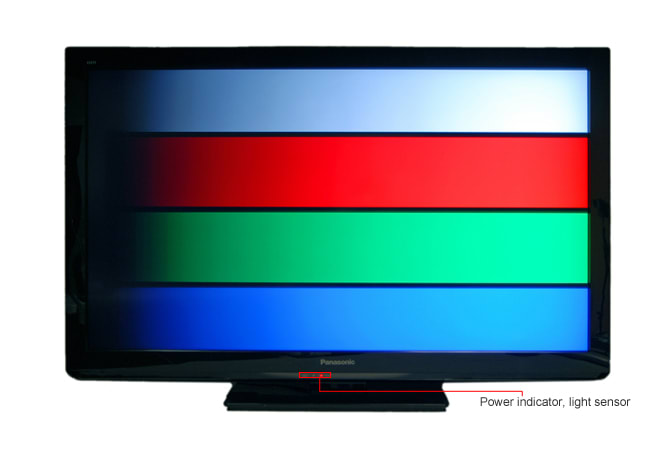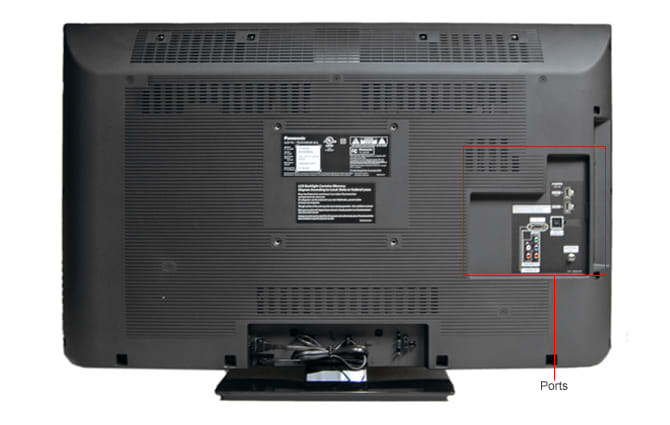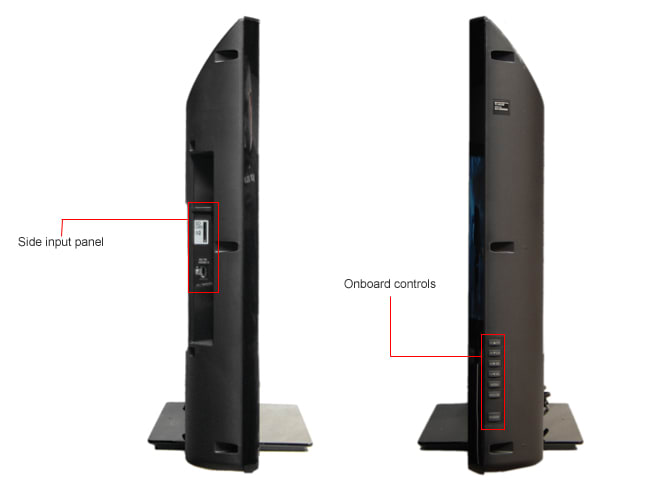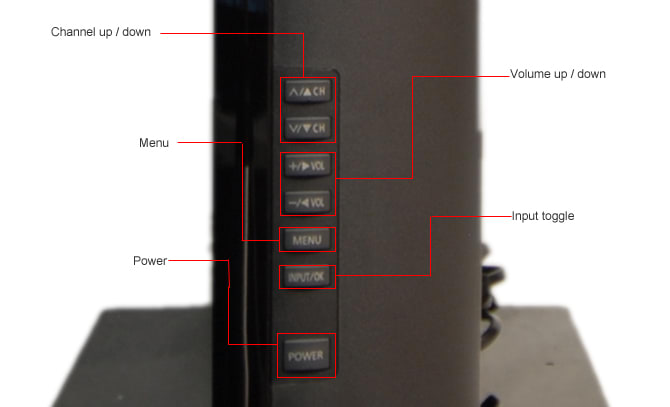Pros
Cons
Introduction
The Panasonic TC-L42U30 has an average core performance with a few egregious flaws, and like any entry-level TV, performs better in some situations than in others: it would be great for kids' shows and movies, but not to have the guys over to watch the big game or a movie.
Tour & Design
The front of the Panasonic TC-L42U30 is a flat, glossy black affair with a simple appearance. Not excessively boxy like previous models, it still does little to impress, but does not do much to draw attention away from the screen either. On the bottom of the screen are the indicator lights and sensors.

On the back of the Panasonic TC-L42U30 are most of the input ports, with the SD/SDHC card slot and one HDMI in port off to one side for easier access. The power cable is hard-wired into the casing of the set, and protrudes near the base of the TV. For information about the ports on the back of the Panasonic TC-L42U30 see our Connectivity section.

The Panasonic TC-L42U30 has a depth of 4.3 inches, which is a bit thick considering the fact that this is an LED-backlit LCD TV. On the left side of the set is an input panel for easy access that has an SD/SDHC card slot and an HDMI input port. On the right side of the set are the manual control buttons. For information about the ports on the sides of the Panasonic TC-L42U30 see our Connectivity section.

The Panasonic L42U30 has a glossy black plastic stand that screws into a metal neck piece, which in turn screws into the TV itself. Though the stand itself is sturdy, the base feels like it's made of cheap plastic, as it is fairly light. The stand is unable to swivel, making port access a chore.
The on-set controls are located on the right side of the TV casing, near the bottom of the right side. The plastic buttons are responsive and easy to operate, but there is no backlighting, which makes seeing them in the dark difficult.

The Panasonic TC-L42U30's remote is identical in every way to the remotes of the 2010 model year Panasonic TV sets. In contrast to the glossy bezel, the remote is a matte black plastic affair, which is lightweight with rubber buttons. The key travel is quite bad, meaning it takes a lot of work to press each button all the way, slowing operation of the controls considerably.
The Panasonic TC-L42U30 comes packaged with remote, batteries, stand, manual and setup instructions.
Blacks & Whites
Color Accuracy
The Panasonic TC-L42U30 earned a mediocre color temperature error score by displaying a noticeable cooling of whites as the signal intensity decreases. While it isn't immediately noticeable, you may see darker areas on your screen gain a slight bluish hue. Still, the Panasonic TC-L42U30 didn't perform too poorly in this test, and on the whole the color temperature error was fairly average for an LCD TV. (More on how we test Color Temperature.)
Disappointingly, the Panasonic TC-L42U30 performed poorly in the RGB color performance test. As you see below, not only are the lines a bit jagged, meaning there were some colors that the TV could simply not produce, but also the blue and red lines peak early. Because of this peak, on the color strips you will notice a distinct color banding, and no distinction between many bright reds and blues. (More on how we test RGB Curves.)
Because this performance was so bad, we tried to recalibrate and re-test the TV set to make the RGB curves better, but the tradeoff in performance was just not worth it. When we lowered the contrast to accommodate the reds and blues, color temperature error skyrocketed, the color gamut suffered some, and the overall color performance plummeted. For whatever reason, contrast cannot be calibrated to accommodate red, green and blue in a way that will allow the viewer to maximize color performance without significant drawbacks. While the results of the RGB testing were disappointing, we do not recommend using an alternate calibration than the one discussed in the calibration section to fix the RGB curves.
The strips below are a linear representation of the RGB color curves, compared against the ideal color response strip, and those of the comparison models for the Panasonic TC-L42U30.
The Panasonic TC-L42U30 did fairly well with displaying colors close to the rec. 709 standard, but did display some oversaturated blues and slightly inaccurate whites. Despite these minor shortcomings, the red and green points were very close to ideal. (More on how we test Color Gamut.)
If you'd like to see the exact measurements that we used to calculate color error, the table below contains all of the pertinent data.
Motion
The Panasonic TC-L42U30 seemed to perform fairly poorly in motion performance, with significant artifacting issues. The Panasonic TC-L42U30 displayed normal loss of detail with all advanced features disabled, which seemed to be corrected by the Motion Picture Pro 4 setting. It is worthy of mention, however, that you may find that this feature usually makes any film-based content that you watch look rather weird with the absence of motion blurring. (More on how we test Motion.)
Though the Motion Picture Pro 4 setting seems to correct many of the problems with motion smoothness, false color trails and blurriness, it did not do so well in consistently preventing artifacting in moving pictures. We find this a bit puzzling because it's performed fairly well in the past. Though it did a good job in limiting artifacting in photos and color charts, it made the picture even worse with line patterns than it was with the feature turned off (fairly bad), which understandably hurt its score.
The Panasonic TC-L42U30 showed only a minor hiccup in its 3:2 pulldown performance, which was corrected quickly by its automatic 3:2 setting. We recommend leaving this setting in the "auto" position for the best results. (More on how we test 3:2 Pulldown and 24fps.)
The Panasonic TC-L42U30 has a native resolution of 1080p, but it is also capable of displaying content at other resolutions as well. Though it handled the task of rescaling well, the user is only able to eliminate overscan in the 1080i/p resolutions via an unlocked "HD size" setting in the advanced picture menu. (More on how we test Resolution Scaling.)
480p
While displaying 480p content, the TV lost 2% on each side to overscan.
720p
While displaying 780p content, the TV lost 2% on each side to overscan. The Panasonic TC-L42U30 also shows significant struggles with Moiré patterns.
1080i
While none of the screen resolution was lost to overscan, the Panasonic TC-L42U30 showed false coloration in many places where tightly-packed white and black lines were displayed. Legibility of print also dropped slightly.
Viewing Effects
The Panasonic TC-L42U30 has a native resolution of 1080p and can display all standard NTSC resolutions.
For an LCD TV, the Panasonic TC-L42U30 has a decent viewing angle, with minimal false coloration or solarization. While there is a significant dropoff in contrast at 34 degrees away from center on either side, this is a pretty good performance as far as LCD TVs go. If viewing angle is a chief concern of yours, plasma TVs tend to perform better than LCD TVs in this regard.( More on how we test Viewing Angle.)
The Panasonic TC-L42U30 has a reflective screen, no matter what angle the light source is shining on it. While the reflection can be annoying regardless of what's on the screen, it isn't always as bright as it is on other TVs. We can see that it's trying to disperse the light somewhat, as there is a rainbow sunburst pattern on the screen, but that usually doesn't do much to lessen the prominence of the reflection. (More on how we test Reflectance.)
The Panasonic TC-L42U30 has several video processing modes, most of which seem to do very little, but a few will change your viewing experience noticeably.
Calibration
[

](http://www.displaymate.com/)The Panasonic TC-L42U30 is not difficult to calibrate, as the picture adjustment menu is simple and straightforward to use. However, we would like to remind you that no matter what settings you adjust the set to, you will never get a perfect color performance for the reasons explored earlier in this review. We adjusted some of the default settings to meet our testing parameters, as listed in the chart below.
There are a handful of video modes to choose from on the Panasonic TC-L42U30, each suited for a specific viewing condition.
Connectivity
The Panasonic TC-L42U30 has a handful of input ports, allowing use of many of the standard connections any user should be accustomed to. In addition to the component/composite hybrid port, the 3 HDMI ports and coaxial cable in, there is an SD/SDHC card slot on the side panel of the TV set which seems to be present on many Panasonic LCD TVs.
The Panasonic TC-L42U30 has fewer ports than we're accustomed to, but this is something we've seen with other 2011 LCD TVs. Like the other TVs we've seen, the Panasonic TC-L42U30 has a shared component/composite input port in the back of the set. While it may have cut costs for Panasonic, this choice of input ports is a little puzzling, as it means that users cannot use more than one component or composite device at a time.

Like it was with its predecessors, the Panasonic TC-L42U30's ports are easy to identify and access. Similarly, the Panasonic TC-L42U30 has a side panel with some of the ports, but this model of Panasonic LCD TV only has an HDMI port and the SD/SDHC card slot on it. All other ports are on the back of the set.

The following is a chart comparing the number and types of port available on the Panasonic TC-L42U30 against similar competitor models.
All of the Panasonic TC-L42U30's input ports are located on the back of the TV set, minus the SD/SDHC card slot, which is on the left side of the TV set, along with the third HDMI port. The rear input panel is difficult to reach, however, as the stand does not swivel. This forces the user to physically move the entire TV set or fish around the back blindly should they want to change inputs, which is now more likely to happen now that the Panasonic TC-L42U30 has only one shared component/composite video in. That being said, all ports are clearly marked and easily located.
Audio & Menus
The Panasonic TC-L42U30 is by no means a replacement for a dedicated 5.1-channel surround sound system, but its performance is about par for the course in its price range. Though you can manually adjust the bass and treble levels in the audio settings menu, there is no true equalizer. The Panasonic TC-L42U30 also has a simulated surround sound option that improves sound quality a bit, but nobody would think for a minute that it actually was a real surround sound system.
The Panasonic TC-L42U30 has a very standard, easy to navigate menu with few aesthetic frills. The left-aligned menu seems to take up a good chunk of the screen, often obscuring the view of whatever you're watching as it is not transparent to a large degree. While simplicity does have its advantages, the controls to alter settings are a bit annoying, as only the d-pad can be used. Should you hit the OK button, nothing will happen at all, and you'll sit around for a minute or two trying to figure out if the remote actually works or not until you realize that what would work for any other TV does not always work on a Panasonic.
The Panasonic TC-L42U30's operating instructions manual is not only informative, but clear and easy to read. Panasonic seems to have gone out of its way to make sure that the user knows exactly what they want to do and where to find whatever they're looking for. Though the table of contents isn't always straightforward, but the tabbed manual itself in concise enough to find information not specifically addressed in the table of contents easily. You can find the Panasonic TC-L42U30's manual online here.
Multimedia & Internet
The Panasonic TC-L42U30 has no ethernet connectivity, nor wireless, and therefore no DLNA support.
The Panasonic TC-L42U30 can play back .jpg photos stored on an SD or SDHC card (for xD, miniSD or microSD, you will have to use an adapter). By pressing the "SD CARD" button on the remote at any time, you can access the photo viewer menu quickly. There, you can set up a slide show, browse your photos or alter picture settings. Unfortunately, you cannot add your own music to the slide shows, as any media files that do not have the .jpg file extension will not be read.
The Panasonic TC-L42U30 does not play any other type of media.
Power Consumption
The Panasonic TC-L42U30 draws a fairly hefty amount of power under recommended settings for an LCD TV, but it could do worse. Our calculations put annual cost of power consumption of $23.78 when you set the backlight to the minimum recommended setting. If you prefer to keep the backlight set to maximum, you can expect to pay around $29.10 per year in power costs. (More on how we test Power Consumption.)
If you look at the chart below, you can see that the Panasonic TC-L42U30 costs more per year to operate than the competitive models from other brands, but it draws much less power than the Panasonic TC-L42U25. Still, this power draw is a bit mystifying as all three comparison models use the much less efficient CCFL backlighting. An LED-backlit TV should not draw this much power, at least it shouldn't at this size.
Vs. Panasonic TC-L42U25
Value Comparison Summary
While the Panasonic TC-L42U30 and the Panasonic L42U25 are relatively similar television sets, in terms of value, it depends on what you, the consumer value in your TV set. While the Panasonic TC-L42U25 costs more to operate and has a poorer picture performance, it has more legacy analog input ports where the Panasonic TC-L42U30 has only 1 analog video in. Though the Panasonic TC-L42U25's MSRP is $100 higher, at this point in its life cycle you could probably easily find it for less.
Blacks & Whites
Though the overall performance of each television set in this area was unimpressive, the Panasonic TC-L42U30 has a much better peak brightness than the Panasonic TC-L42U25, as well as a better contrast ratio.
Color Accuracy
While the color temperature error of the Panasonic TC-L42U30 is not as consistent as that of the Panasonic TC-L42U25, it does manage to stay below the threshold of perceptibility to the human eye for a greater range of signal intensity than the Panasonic TC-L42U25. Consequently, the Panasonic TC-L42U30 scored much higher marks in this category. However, the Panasonic TC-L42U30 did a very poor job with the RGB curves, where the Panasonic TC-L42U25 did not have this difficulty. Note the color banding in the Panasonic TC-L42U30's red and blue strips, where the Panasonic TC-L42U25 does not have them in any strip.
Motion
It's a bit surprising that a newer television from the same company would have slipped in its motion performance, but alas, the Panasonic TC-L42U30 has suffered some in this category. Its bad score is quite the step back from the older TC-L42U25's mediocre one, and even the motion enhancement setting Motion Picture Pro 4 seemed to help the blurriness, but generate artifacting that previously wasn't there.
Viewing Effects
The Panasonic TC-L42U30 shows a dramatic improvement in viewing angle over the Panasonic TC-L42U25. Though the latter television has about an average viewing angle for an LCD TV, the Panasonic TC-L42U30 has an impressive one, offering 11 degrees more on either side (total angle is about 69 degrees).
Connectivity
Panasonic decided to do away with the 2 composite video inputs in favor of a shared component/composite one for the TC-L42U30. Beyond that, the Panasonic TC-L42U30 and the Panasonic TC-L42U25 are virtually identical in their connectivity options. Keep in mind, though, that the Panasonic TC-L42U30 has less analog video input, so if you use more than one external media player that requires an analog input cable, you will run into problems that don't exist on the Panasonic TC-L42U25.
Vs. Sony KDL-40EX400
Value Comparison Summary
While the Panasonic TC-L42U30 has a better screen size, the Sony KDL-40EX400 sports more input ports, a lower annual cost to operate and a much lower MSRP. Though the KDL-40EX400 is a bit older than the Panasonic TC-L42U30, it still has a comparable performance in many areas to the Panasonic TC-L42U30, and gives you more bang for your buck.
Blacks & Whites
The Sony KDL-40EX400 blew away the Panasonic TC-L42U30 in terms of black and white performance. Not only does it have a much better contrast ratio, but it a deeper black as well. Though the Panasonic TC-L42U30 has a higher peak white, really anything above 200cd/m2 will be more than sufficient for viewing in a bright room, making the difference between those two values less important than the others.
Color Accuracy
The Sony KDL-40EX400 and the Panasonic TC-L42U30 have similar scores in the color temperature error measurements we took, but if you refer to the charts below, you'll see that the Sony KDL-40EX400's error strays into the range of perceptibility to the human eye far less often than the Panasonic TC-L42U30's does. Still, with either TV, you are very unlikely to notice this even if you are trying to find it, and even then the error is fairly small compared to some other TVs.
In terms of RGB curves, the Panasonic TC-L42U30 did not perform so well unless we altered the settings to improve its performance in this area only, so naturally the Sony KDL-40EX400 fared much better than the Panasonic TC-L42U30 in our testing.
Motion
Though the Sony KDL-40EX400 did not wow us in terms of motion performance, the Panasonic TC-L42U30 did not either, and both TV sets had roughly equivalent scores in our testing.
Viewing Effects
The Panasonic TC-L42U30 separates itself from the Sony KDL-40EX400 in the viewing effects category by having less color inversion or solarization in the picture, but they have roughly the same viewing angle.
Connectivity
The Sony KDL-40EX400 outshines the Panasonic TC-L42U30 in connectivity options, as it not only has more HDMI ports, but also dedicated composite and component video inputs where the Panasonic TC-L42U30 has only the shared port. In addition, the Sony KDL-40EX400 has USB connectivity, where the Panasonic TC-L42U30 has an SD/SDHC card slot.
Vs. Sharp LC-42SB48UT
Value Comparison Summary
The Sharp LC-42SB48UT is a very similar TV to the Panasonic TC-L42U30 in many ways, but there are certain tradeoffs in performance that you will have to consider when purchasing a TV. Where the Sharp LC-42SB48UT has far more connectivity options than the Panasonic TC-L42U30, it has a much narrower viewing angle. Because these TV sets are close in price and in many aspects of performance, the advantages one TV offers over the other are more dependent on the desired use.
Blacks & Whites
Like the Sony KDL-40EX400, the Sharp LC-42SB48UT also far outperformed the Panasonic TC-L42U30 in black and white performance, with a very low deepest black and high contrast ratio. Again, the Sharp LC-42SB48UT may not have displayed as high of a peak white, but it did more than well enough in this area for viewing in a bright room.
Color Accuracy
The Sharp LC-42SB48UT scored higher marks than the Panasonic TC-L42U30 in our color temperature error tests, as it displayed a smaller range of signal intensity with noticeable error to the human eye. Though you will most likely not see the color temperature error on either screen, the Sharp LC-42SB48UT is clearly superior in this area. Interestingly, the Sharp LC-42SB48UT had similar troubles with RGB curves to the Panasonic TC-L42U30 in that its reds peaked very early. However, unlike the Panasonic TC-L42U30, the degree to which this was a problem was much less than the Panasonic TC-L42U30's, and even though the Sharp LC-42SB48UT did not do extremely well by this metric, it was still much better than the Panasonic TC-L42U30's performance.
Motion
Because the Panasonic TC-L42U30 has such a bad score with motion performance, even TVs with average scores in this area will be noticeably better in this regard, like the Sharp LC-42SB48UT.
Viewing Effects
Where the Panasonic TC-L42U30 truly outshines the Sharp LC-42SB48UT is in the viewing angle measurements. Where the LC-42SB48UT has a viewing angle that is limited to 14.27 degrees from the center of the screen on either side, the Panasonic TC-L42U30 boasts a 34.48 degree viewing angle from either side. This means that for viewing in large groups of people, the Panasonic TC-L42U30 will be a much better fit.
Connectivity
The Sharp LC-42SB48UT also outshines the Panasonic TC-L42U30 in terms of connectivity options, as it too sports more analog video and audio ports. In addition, the Sharp LC-42SB48UT has USB connectivity where the Panasonic TC-L42U30 has an SD/SDHC card slot. If analog options are important to you, the Sharp LC-42SB48UT is a better option.
Conclusion
Series Comparison
TC-LXXU3X Series
The three televisions are somewhat basic models, each with the same ports and features outside of Motion Picture Pro 4 120hz, which is only available on the Panasonic TC-L42U30.
Meet the tester
A seasoned writer and professional photographer, Chris reviews cameras, headphones, smartphones, laptops, and lenses. Educated in Political Science and Linguistics, Chris can often be found building a robot army, snowboarding, or getting ink.
Checking our work.
Our team is here to help you buy the best stuff and love what you own. Our writers, editors, and experts obsess over the products we cover to make sure you're confident and satisfied. Have a different opinion about something we recommend? Email us and we'll compare notes.
Shoot us an email